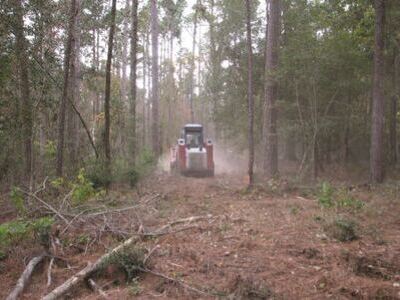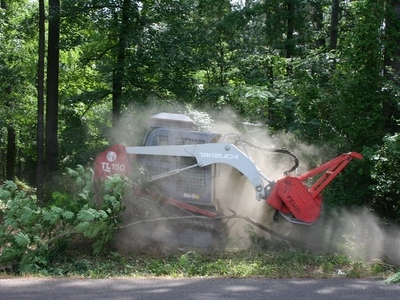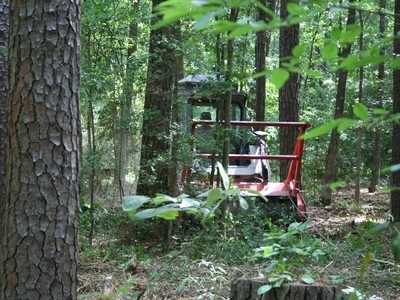Site preparation

Site preparation is treating land to improve planting conditions, encourage germination of seed or growth of seedlings, and promote survival of desired species. The main components of site preparation involve reducing standing woody and herbaceous vegetation and mixing organic material back into the soil.
The method, intensity, and timing of site preparation depends on site conditions, target species, groundcover type, and soils. Site preparation methods that remove existing herbaceous and woody vegetation reduce hazardous fuels, limiting the intensity and spread of wildfires.
Planning
Site preparation treatments should be complete so that planting will be conducted within six months.

conducts a mulching operation.
Define the treatment area where you plan to plant trees. No more than 25% of the project area should be left untreated. Large treatment areas may need to be divided into manageable sections for site preparation.
The treatment area should be clearly marked using paint or flagging. Flagging should also be used to identify individual plant specimens to be protected, or special areas within the treatment zone to be avoided. Native tree species with a diameter at breast height (DBH, measured at 4.5 feet above ground on the uphill side) greater than four inches should be marked and retained. Our foresters can assist landowners in identifying beneficial native species that should be preserved.
Most site preparation methods require equipment operators to have road access to the treatment area. Inspect the area you plan to shred or mulch for hidden objects that may damage equipment or spark a fire. Remove the objects or mark them with paint or flagging for the operator to avoid.
Treatment should begin along the perimeter of the treatment area to delineate the site. The rest of the treatment should be conducted running along the contour of the land to reduce soil erosion and water channeling. To create a uniform treatment, allow 10-15% overlap between passes to treat any initially missed vegetation. Especially dense brush may require an initial pass with equipment raised to remove the tops of vegetation, followed by a second pass with the blades several inches lower. The final shredding pass should be completed at a height of two to four inches.
Treatments that involve covering the area in multiple passes can be conducted over several days, which will allow the initial cut vegetation to dry and settle lower to the ground, reducing the wear on equipment. Operators can expect to drive machinery between two to four mph for a typical mulching treatment. Thick brush may require slower tractor speeds (one to two mph) to ensure the vegetation is thoroughly mulched, while lighter grasses may be sufficiently reduced at higher tractor speeds (three to four mph).
Mulching can be conducted at any time up to six months pre-planting. Though still green, living vegetation present during the growing season mulches best. An herbicide application following the mulching will help eliminate or control regrowth from unwanted vegetation.
Sites with large rocks or other debris incapable of being mulched, or sites with excessive slopes or extreme wetness may not be suitable for machine mulching.
Mechanical site preparation

Mechanical site preparation methods involve using machinery to remove unwanted vegetation and improve soil conditions. The use of heavy machinery and practice that may disturb soil conditions should follow the contour of the land to prevent excessive soil erosion.
Shredding involves using rotary cutting devices (such as a Brush Hog) to cut standing herbaceous vegetation to a height of two to four inches.
Mulching involves using machinery to cut, break, and shred larger woody vegetation into small pieces to be spread over a site.
As with other methods of site preparation that incorporate organic debris into soil cover, both shredding and mulching reduce erosion potential and stabilize the soil, making them useful options for highly erosive sites. Organic mulch left on site reincorporates nutrients into the soil, improves soil moisture retention, and reduces soil temperature fluctuations, improving growing conditions for newly planted trees.
Because the mulch is produced on-site, there are no costs outside labor and machine rental, and there is low risk of introducing non-native species into the treatment area. Mulching may also aid in natural seed generation as cones and seeds are incorporated into the soil.
The type of mower/mulcher for site preparation depends on the present conditions of the treatment area. A tractor’s horsepower and power take-off (PTO) capability should be considered when choosing individual equipment.
Chemical site preparation
Herbicide treatment is often used in conjunction with mechanical site preparation to achieve the desired conditions before planting. For example, a property manager may initially remove large amounts of unwanted vegetation through mulching or prescribed burning and treat the area later with a target-specific herbicide.
Herbicide mixtures kill woody and/or herbaceous vegetation and prevent future root sprouts which may compete with planted seedlings for nutrients, water, and sunlight. Herbicides are site-specific based on the species to be controlled, soils, proximity to streams, and sensitivity of adjacent vegetation. Herbicides broadcast sprayed over large areas are spread by air (via a helicopter) or on the ground (with a skidder). Herbicides may also be spot sprayed during the first growing season following planting as part of herbaceous weed control.
The type and timing of herbicide application depends on the site conditions, project goals, and herbicide type. Follow all labeled instructions. Identify and establish buffer areas to reduce the chance of herbicide and herbicide-contaminated rinse waters from entering surface waters.
All restricted use pesticides, and any herbicide applied for compensation must be applied by a Texas Licensed Pesticide Applicator.
Site preparation best practices
All project work should adhere to Texas Forestry Best Management Practices.
- Minimize soil compaction by operating machinery along the contour of the land and avoid operating when soils are saturated. Use wide-tire skidders to minimize rutting. If present soils are highly erodible, alternative site preparation methods may be appropriate.
- Plant soon after treatment to avoid unwanted species from reestablishing.
- Leave organic debris on site. Plant materials cut during site preparation can be reincorporated into the soil, recycling nutrients and improving soil moisture. Woody debris may also act as ground cover to reduce soil erosion.